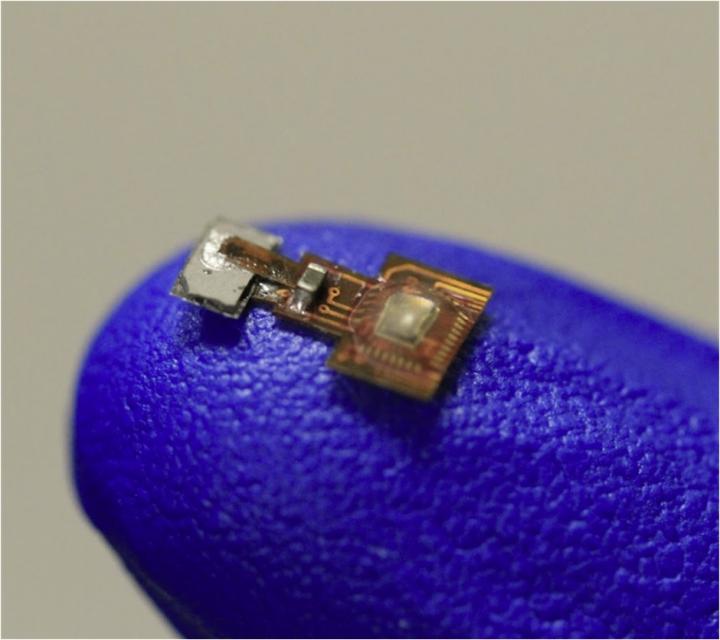Rice engineer’s MagNI can be wirelessly charged and programmed with magnetic fields

Credit: Secure and Intelligent Micro-Systems Lab/Rice University
HOUSTON – (Feb. 19, 2020) – A team of Rice University engineers has introduced the first neural implant that can be both programmed and charged remotely with a magnetic field.
Their breakthrough may make possible imbedded devices like a spinal cord-stimulating unit with a battery-powered magnetic transmitter on a wearable belt.
The integrated microsystem, called MagNI (for magnetoelectric neural implant), incorporates magnetoelectric transducers. These allow the chip to harvest power from an alternating magnetic field outside the body.
The system was developed by Kaiyuan Yang, an assistant professor of electrical and computer engineering; Jacob Robinson, an associate professor of electrical and computer engineering and bioengineering; and co-lead authors Zhanghao Yu, a graduate student, and graduate student Joshua Chen, all at Rice’s Brown School of Engineering.
Yang introduced the project today at the International Solid-State Circuits Conference in San Francisco.
MagNI targets applications that require programmable, electrical stimulation of neurons, for instance to help patients with epilepsy or Parkinson’s disease.
“This is the first demonstration that you can use a magnetic field to power an implant and also to program the implant,” Yang said. “By integrating magnetoelectric transducers with CMOS (complementary metal-oxide semiconductor) technologies, we provide a bioelectronic platform for many applications. CMOS is powerful, efficient and cheap for sensing and signal processing tasks.”
He said MagNI has clear advantages over current stimulation methods, including ultrasound, electromagnetic radiation, inductive coupling and optical technologies.
“People have been demonstrating neural stimulators on this scale, and even smaller,” Yang said. “The magnetoelectric effect we use has many benefits over mainstream methods for power and data transfer.”
He said tissues do not absorb magnetic fields as they do other types of signals, and will not heat tissues like electromagnetic and optical radiation or inductive coupling. “Ultrasound doesn’t have the heating issue but the waves are reflected at interfaces between different mediums, like hair and skin or bones and other muscle.”
Because the magnetic field also transmits control signals, Yang said MagNI is also “calibration free and robust.”
“It doesn’t require any internal voltage or timing reference,” he said.
Components of the prototype device sit on a flexible polyimide substrate with only three components: a 2-by-4-millimeter magnetoelectric film that converts the magnetic field to an electric field, a CMOS chip and a capacitor to temporarily store energy.
The team successfully tested the chip’s long-term reliability by soaking it in a solution and testing in air and jellylike agar, which emulates the environment of tissues.
The researchers also validated the technology by exciting Hydra vulgaris, a tiny octopuslike creature studied by Robinson’s lab. By constraining hydra with the lab’s microfluidic devices, they were able to see fluorescent signals associated with contractions in the creatures triggered by contact with the chips. The team is currently performing in-vivo tests of the device on different models.
In the current generation of chips, energy and information flow only one way, but Yang said the team is working on two-way communication strategies to facilitate data collection from implants and enable more applications.
###
Co-authors of the paper presented at the conference are Rice graduate students Yan He and Amanda Singer and research specialist Benjamin Avants.
A paper on the topic, “An 8.2mm3 Implantable Neurostimulator with Magnetoelectric Power and Data Transfer,” will be available on the IEEE Xplore Digital Library.
This news release can be found online at https:/
Follow Rice News and Media Relations via Twitter @RiceUNews.
Related materials:
Secure and Intelligent Micro-Systems Lab (Yang group): http://vlsi.
Robinson Lab: https:/
George R. Brown School of Engineering: https:/
Images for download:
https:/
Rice University introduced the first neural implant that can be programmed and charged remotely with a magnetic field at the International Solid-State Circuits Conference. (Credit: Secure and Intelligent Micro-Systems Lab/Rice University)
https:/
Rice University graduate students Joshua Chen, left, and Zhanghao Yu test a prototype neural implant that can be programmed and charged remotely with a magnetic field. The chip may make possible imbedded devices like a spinal cord-stimulating unit with a battery-powered magnetic transmitter on a wearable belt. (Credit: Jeff Fitlow/Rice University)
https:/
Rice University engineers have introduced the first neural implant that can be programmed and charged remotely with a magnetic field. From left, Kaiyuan Yang, Zhanghao Yu, Joshua Chen and Jacob Robinson. (Credit: Jeff Fitlow/Rice University)
Located on a 300-acre forested campus in Houston, Rice University is consistently ranked among the nation’s top 20 universities by U.S. News & World Report. Rice has highly respected schools of Architecture, Business, Continuing Studies, Engineering, Humanities, Music, Natural Sciences and Social Sciences and is home to the Baker Institute for Public Policy. With 3,962 undergraduates and 3,027 graduate students, Rice’s undergraduate student-to-faculty ratio is just under 6-to-1. Its residential college system builds close-knit communities and lifelong friendships, just one reason why Rice is ranked No. 1 for lots of race/class interaction and No. 4 for quality of life by the Princeton Review. Rice is also rated as a best value among private universities by Kiplinger’s Personal Finance.
Jeff Falk
713-348-6775
[email protected]
Mike Williams
713-348-6728
[email protected]
Media Contact
Mike Williams
[email protected]
713-348-6728
Original Source
https:/




